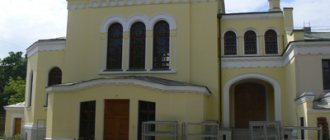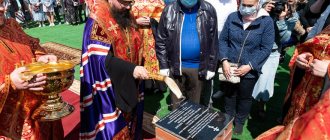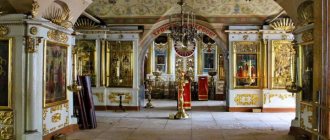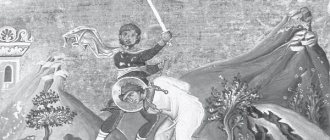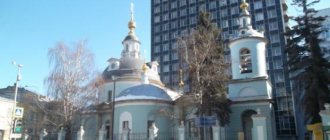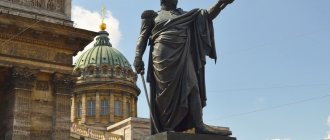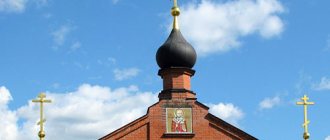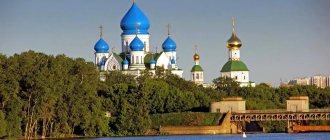Mir
Russia Moscow Temple of Sophia the Wisdom of God at the Cannon Yard (Moscow) Map is loading...
{"format":"leaflet","minzoom":false,"maxzoom":false,"limit":50,"offset":0,"link":"all","sort":[""], "order":[],"headers":"show","mainlabel":"","intro":"","outro":"","searchlabel":"\u2026 \u0441\u043b\u0435\ u0434\u0443\u044e\u0449\u0438\u0435 \u0440\u0435\u0437\u0443\u043b\u044c\u0442\u0430\u0442\u044b","default":"","import-annotation":false,"width ":"auto","height":"350px","centre":{"text":"","title":"""link":"""lat":55.7607220000000012305463314987719058990478515625,"lon": 37.625675000000001091393642127513885498046875,"icon":""},"title":"","label":"","icon":"","lines":[],"polygons":[],"circles":[ ],"rectangles":[],"copycoords":false,"static":false,"zoom":8,"defzoom":14,"layers":["OpenStreetMap"],"image layers":[] ,"overlays":[],"resizable":false,"fullscreen":true,"scrollwheelzoom":true,"cluster":false,"clustermaxzoom":9,"clusterzoomonclick":true,"clustermaxradius":80, "clusterspiderfy":true,"geojson":"","clicktarget":"","showtitle":true,"hidenamespace":false,"template":"","userparam":"","activeicon": "","pagelabel":false,"ajaxcoordproperty":"","ajaxquery":"","locations":[{"text":"\u003Cb\u003E\u003Ca href=\"/palomnik/%D0% A5%D1%80%D0%B0%D0%BC_%D0%A1%D0%BE%D1%84%D0%B8%D0%B8_%D0%9F%D1%80%D0%B5%D0%BC% D1%83%D0%B4%D1%80%D0%BE%D1%81%D1%82%D0%B8_%D0%91%D0%BE%D0%B6%D0%B8%D0%B5%D0% B9_%D1%83_%D0%9F%D1%83%D1%88%D0%B5%D1%87%D0%BD%D0%BE%D0%B3%D0%BE_%D0%B4%D0%B2% D0%BE%D1%80%D0%B0_(%D0%9C%D0%BE%D1%81%D0%BA%D0%B2%D0%B0)\» title=\»\u0425\u0440\u0430\ u043c \u0421\u043e\u0444\u0438\u0438 \u041f\u0440\u0435\u043c\u0443\u0434\u0440\u043e\u0441\u0442\u0438 \u0411\u043e\u0436\u 0438\u0435\u0439\u0443\u041f\ u0443\u0448\u0435\u0447\u043d\u043e\u0433\u043e \u0434\u0432\u043e\u0440\u0430 (\u041c\u043e\u0441\u043a\u0432\u0430)\»\u003E \u0425\u0440\u0430\ u043c \u0421\u043e\u0444\u0438\u0438 \u041f\u0440\u0435\u043c\u0443\u0434\u0440\u043e\u0441\u0442\u0438 \u0411\u043e\u0436\u 0438\u0435\u0439\u0443\u041f\ u0443\u0448\u0435\u0447\u043d\u043e\u0433\u043e \u0434\u0432\u043e\u0440\u0430 (\u041c\u043e\u0441\u043a\u0432\u0430)\u003C/a \u003E\u003C/b\ u003E\u003Chr /\u003E\u003Ca href=\»/palomnik/%D0%A1%D0%B2%D0%BE%D0%B9%D1%81%D1%82%D0%B2%D0%BE:%D0 %90%D0%BD%D0%BD%D0%BE%D1%82%D0%B0%D1%86%D0%B8%D1%8F\" title=\"\u0421\u0432\u043e\u0439\u0441 \u0442\u0432\u043e:\u0410\u043d\u043d\u043e\u0442\u0430\u0446\u0438\u044f\»\u003E\u0410\u043d\u043d\u043e\u0442\u0430\u0446 \u0438\u044f\u003C/ a\u003E: "'\u0425\u0440\u0430\u043c \u0421\u043e\u0444\u0438\u0438 \u041f\u0440\u0435\u043c\u0443\u0434\u0440\u043e\u0441\u0 442\u0438\u0411\u043e \u0436\u0438\u0435\u0439 \u0443 \u041f\u0443\u0448\u0435\u0447\u043d\u043e\u003Cspan class=\"smw-highlighter\" data-type=\"2\" data-state=\" persistent\" data-title=\"\u0418\u043d\u0444\u043e\u0440\u043c\u0430\u0446\u0438\u044f\" title=\"\u0026#039;\u0026#039;\u0026#039; \u0425\u0440\u0430\u043c \u0421\u043e\u0444\u0438\u0438 \u041f\u0440\u0435\u043c\u0443\u0434\u0440\u043e\u0441\u0442\u0438 \u0411\u043e\u0436\u0438\u0435 \u0439 \u0443 \u041f\u0443\u0448\u0435\u0447\u043d\u043e\u0433\u043e \u0434\u0432\u043e\u0440\u0430\u0026#039;\u0026#039;\u 0026#039;, \u0447 \u0442\u043e \u043d\u0430 \u041b\u0443\u0431\u044f\u043d\u043a\u0435 (\u0425\u0440\u0430\u043c \u0421\u043e\u0444\u0438\u043 8\u041f\u0440\u0435\u043c\ u0443\u0434\u0440\u043e\u0441\u0442\u0438 \u0411\u043e\u0436\u0438\u0435\u0439 \u043d\u0430 \u0421\u043e\u0444\u0438\u0439\u 043a\u0435)\u2014\u043f\u0440 \u0430\u0432\u043e\u0441\u043b\u0430\u0432\u043d\u044b\u0439 \u0445\u0440\u0430\u043c, \u043f\u0440\u0438\u043d\u0430\u0434 \u043b\u0435\u0436\u0430\ u0449\u0438\u0439 \u043a \u0421\u0440\u0435\u0442\u0435\u043d\u0441\u043a\u043e\u043c\u0443 \u0431\u043b\u0430\u0433\u043e\u 0447\u0438\u043d\u0438\u044e\ u041c\u043e\u0441\u043a\u043e\u0432\u0441\u043a\u043e\u0439 \u0433\u043e\u0440\u043e\u0434\u0441\u043a\u043e\u0439 \u0435\u0 43f\u0430\u0440\u0445\u0438\ u0438 \u0420\u0443\u0441\u0441\u043a\u043e\u0439 \u043f\u0440\u0430\u0432\u043e\u0441\u043b\u0430\u0432\u043d\u043e\u0439 \u 0446\u0435\u0440\u043a\u0432\ u0438. \u0421\u0443\u0449\u0435\u0441\u0442\u0432\u0443\u044e\u0449\u0430\u044f \u0426\u0435\u0440\u043a\u043e\u0432\u044c \u0432\ u044b\u0441\u0442\u0440\u043e \u0435\u043d\u0430 \u0432 1692 \u0433. \u043d\u0430 \u043c\u0435\u0441\u0442\u0435 \u0434\u0435\u0440\u0435\u0432\u044f\u043d\u043d\u043e\u0439.\"\u003E\u003Cspan class= \"smwtext\"\u003E \u2026 \u003C/span\u003E\u003Cspan class=\»smwttcontent\»\u003E»'\u0425\u0440\u0430\u043c \u0421\u043e\u0444\u0438\u0438 \u041f\u0440\u043 5\u043c\u0443\ u0434\u0440\u043e\u0441\u0442\u0438 \u0411\u043e\u0436\u0438\u0435\u0439 \u0443 \u041f\u0443\u0448\u0435\u0447\u043d\u043e\u 0433\u043e\u0434\u0432\u043e\ u0440\u0430"', \u0447\u0442\u043e \u043d\u0430 \u041b\u0443\u0431\u044f\u043d\u043a\u0435 (\u0425\u0440\u0430\u043c \u0421\u0 43e\u0444\u0438\u0438\ u041f\u0440\u0435\u043c\u0443\u0434\u0440\u043e\u0441\u0442\u0438 \u0411\u043e\u0436\u0438\u0435\u0439 \u043d\u0430 \u0421\u 043e\u0444\u0438\u0439\u043a\ u0435) \u2014 \u043f\u0440\u0430\u0432\u043e\u0441\u043b\u0430\u0432\u043d\u044b\u0439 \u0445\u0440\u0430\u043c, \u043f\u044 0\u0438\u043d\u0430\u0434\ u043b\u0435\u0436\u0430\u0449\u0438\u0439 \u043a \u0421\u0440\u0435\u0442\u0435\u043d\u0441\u043a\u043e\u043c\u0443 \u0431\u 043b\u0430\u0433\u043e\u0447\ u0438\u043d\u0438\u044e\u041c\u043e\u0441\u043a\u043e\u0432\u0441\u043a\u043e\u0439 \u0433\u043e\u0440\u043e\u0434\u0441\u0 43a\u043e\u0439\u0435\u043f\ u0430\u0440\u0445\u0438\u0438 \u0420\u0443\u0441\u0441\u043a\u043e\u0439 \u043f\u0440\u0430\u0432\u043e\u0441\u043b\u0430\u0 432\u043d\u043e\u0439\u0446\ u0435\u0440\u043a\u0432\u0438. \u0421\u0443\u0449\u0435\u0441\u0442\u0432\u0443\u044e\u0449\u0430\u044f \u0426\u0435\u0440\u043a\u043e\u0432\u044c \u0432\ u044b\u0441\u0442\u0440\u043e \u0435\u043d\u0430 \u0432 1692 \u0433. \u043d\u0430 \u043c\u0435\u0441\u0442\u0435 \u0434\u0435\u0440\u0435\u0432\u044f\u043d\u043d\u043e\u0439.\u003C/span\u003E\u0 03C/span\u003E\u044c\ u0432\u044b\u0441\u0442\u0440\u043e\u0435\u043d\u0430 \u0432 1692 \u0433. \u043d\u0430 \u043c\u0435\u0441\u0442\u0435 \u0434\u0435\u0440\u0435\u0432\u044f\u043d\u043d\u043e\u0439.","title":"\u0425\u0440 \u0430\u043c \u0421\u043e\u0444\u0438\u0438 \u041f\u0440\u0435\u043c\u0443\u0434\u0440\u043e\u0441\u0442\u0438 \u0411\u043e\u0436\u0438\ u0435\u0439\u0443\u041f\u0443 "Link":"""lat" :55.7607220000000012305463314987719058990478515625,"lon":37.625675000000001091393642127513885498046875,"icon":""}],"imageLayers":[]}
55.760768; 37.625666
Russia, Moscow, Pushechnaya street, 15
Moscow
Russia
Telephone:
(495) 914-28-11
Temple of Sophia the Wisdom of God at the Cannon Yard
, which is on Lubyanka (Temple of Sophia of the Wisdom of God on Sofiyka) is an Orthodox church belonging to the Sretensky deanery of the Moscow city diocese of the Russian Orthodox Church. The existing Church was built in 1692 on the site of a wooden one.
History of origin
The first wooden church was built a little further from the place where the temple was built. It was built after the victory of the Muscovites over the army of Novgorod. Its construction was mentioned in ancient chronicles in the 15th century. It was built by forcibly displaced Novgorodians. They revered Sophia the Wisdom and named the temple in her honor. In 1493, the writings indicated that a great fire near the eastern wall of the Kremlin spread to Zarechye and completely destroyed the wooden church.
In 1496, Ivan III issued a decree on the demolition of all buildings near the Kremlin. It was forbidden to build residential premises and churches here. Afterwards, the empty territory was given over to lay out the Great Garden for the sovereign. This area began to be called Tsaritsyn Meadow. A settlement was subsequently built near this territory, in which gardeners lived who looked after the garden. It was thanks to them that this area was called the Gardeners in the future.
Church of St. Sophia, the Wisdom of God, in Sadovniki
| Temple of Sophia the Wisdom of God on Lubyanka. |
In old Moscow there were two churches consecrated in the name of St. Sophia the Wisdom of God.
Both have miraculously survived to this day and are operating again. One of them is located in Zamoskvorechye, the other is in the center of Moscow, on Pushechnaya Street, but both were associated with the Novgorod campaigns of Ivan III. And if the temple on Pushechnaya was founded by the Novgorodians themselves, settlers from Veliky Novgorod, which was conquered by Moscow, then the unique Zamoskvorechnaya temple was erected by Muscovites in honor of their victory over Novgorod. It was he who was destined to play a key role in the urban planning of Orthodox Moscow-Third Rome. The patronal feast is dedicated to the image of Hagia Sophia, the Wisdom of God (from ancient Greek Sophia means Wisdom). The Wisdom of God is the embodiment of the Divine Plan, which foresaw the Fall of man, about the Economy and salvation of the human race through Christ - God the Logos and the Most Pure Mother of God, through whom He was incarnated. That is why this holiday is associated with the Mother of God.
The Icon of Sophia of the Kyiv version, that is, the image from the St. Sophia Church in Kyiv, is honored on September 21, the Nativity of the Virgin Mary. And on August 28, the image of Sophia from the Novgorod version is celebrated - from the Church of St. Sophia in Veliky Novgorod. The celebration of this image on the day of the Assumption glorifies the incarnate Wisdom of God through the full implementation of the Divine Plan, when the Mother of God is glorified as the Queen of Heaven, the Intercessor of the human race before the Heavenly Throne of Her Divine Son. So the feast of Sophia became the triumph of the Most Holy Theotokos.
The icon of Hagia Sophia, expressing the complex image of the Wisdom of God, is executed in fiery tones. In the center of the composition of the icon from the Novgorod version, the Lord Almighty is depicted in a fiery image, in a royal crown and vestments and with fiery wings, sitting on a golden throne that supports seven pillars (“Wisdom created for herself a house and established seven pillars”). Around Him is a starry sky, and on either side of the Lord stand the closest witnesses to the incarnation of the Son of God - the Mother of God in a purple robe with an icon of the Lord Christ and John the Baptist. The main idea of the icon is to present the embodied Wisdom in Her eternal Plan: in the image of Christ the Logos and the Mother of God, through Whom the Divine Plan for the salvation of the world and the human race was embodied. The Mother of God is also presented here as the Queen of the Church, which was founded by the Lord and outside of which, according to Divine Providence, it is impossible to achieve salvation.
Moscow, which conceived itself as the House of the Mother of God, could not help but have its own St. Sophia Church.
In the Moscow St. Sophia churches, the patronal holiday was celebrated according to the Novgorod version, on August 28, since both of these churches were associated with the Novgorod campaigns of Ivan III. However, if the temple on Pushechnaya was an ordinary parish church for Novgorodians resettled in Moscow, who built it in memory of their native city, then the fate of the Zamoskvorechskaya Sophia Church was influenced by the area in which it was founded. Its connection with the Novgorod campaigns of the Moscow prince is indicated by the dedication itself: the Church of Hagia Sophia was the main cathedral of Veliky Novgorod, which was conquered by Moscow under Ivan III. The first wooden church, founded at the end of the 15th century, according to scientists, was located a little further from the place where the stone St. Sophia Church now stands - closer to the House on the Embankment. It was first mentioned in chronicles in 1493.
| Temple of Sophia the Wisdom of God in Zamoskvorechye. |
That year was truly fatal and fateful for Moscow. At that time, ancient Zamoskvorechye was also called Zarechye, where the road to the Horde passed. Here, river floods flooded the coastal area, which is why at first only poor peasants and artisans settled here, and crossing was only by boats, and along a floating bridge that lay right on the water. However, the terrible fire of 1493, which devastated the settlement (the area near the eastern wall of the Kremlin), also reached Zarechye. It was then that a square was formed near the Kremlin in a burnt-out area, which was called Pozhar
, and later - Red.
From now on it was forbidden to settle on it, the settlement moved east of the Kremlin, and Kitay-Gorod arose there. And in Zarechye it was also forbidden to settle opposite the Kremlin and to build residential buildings on the embankment, so that they would no longer be touched by the fire, and the flames would not spread to the Kremlin. In the space vacated by housing, it was necessary to arrange something special. And the Zarechensky territory was given over to the new Sovereign Garden, which was laid out already in 1495 (the Sovereign Gardens by that time existed in the area of Starosadsky Lane near Pokrovka, where there was a country residence of the Grand Duke). So, on the left bank of the Moscow River after the fire, Red Square appeared, on the right - the Great Sovereign Garden, called Tsaritsyn Meadow, the future Gardeners
. A suburban settlement of sovereign gardeners arose near it, caring for the Garden. It was they who gave the later name to the area.
Zarechensky Gardeners became one of the first local palace settlements. This area was generally densely populated by the sovereign's settlements, especially after the reign of Ivan the Terrible, who settled the archers here. Kadashis, royal weavers, moneymen, interpreters, tanners, and blacksmiths lived here, and they all built parish churches - like the gardeners, who had the Church of St. Sophia as their suburban temple. However, at first the sovereign’s gardeners did not live on the territory of the garden, but closer to the Ustinsky Bridge, where Sadovnicheskaya Street remained in memory of them. Only in the 17th century did gardeners settle in the immediate area of the garden itself and in 1682 they built a new stone St. Sophia Church. Not long before, Archpriest Avvakum himself preached in the old church, and “he excommunicated many parishioners with his teaching.” As a result of this “desolation of churches,” he was exiled from Moscow.
As already mentioned, this St. Sophia Church was by no means just a parish church, but had a special, exclusive role in the urban planning concept of Moscow as the Third Rome, becoming a definite symbolic center of Zamoskvorechye. Tsaritsyn Meadow - the Great Sovereign's Garden with the Church of Sophia of the Wisdom of God, was a symbol of the Garden of Gethsemane and a collective image of Paradise. Hence another name came - Tsaritsyn Meadow, symbolizing the dedication of the garden with the St. Sophia Church to the Most Holy Theotokos - the Queen of Heaven. This was also the embodiment of the idea of Moscow as the House of the Mother of God: the dedication of the Russian capital to Her and the prayerful entrustment of Moscow under the shadow of the Queen of Heaven. (There is a version of scientists that such an understanding of Moscow could finally take shape just after the resettlement of the conquered Novgorodians, who called Novgorod the House of Hagia Sophia). This is evidenced by the dedication to the Mother of God of the main cathedral of Moscow - the Assumption Cathedral. By the way, since his patronal feast day coincided with the feast of St. Sophia, the people significantly called the Assumption Cathedral St. Sophia. It was indeed the prototype of the Church of Hagia Sophia in Constantinople, in commemoration of Russia's succession to the Byzantine Empire and its inheritance of the status of the ancient Russian capitals, Kyiv and Vladimir.
The main urban planning composition of the Third Rome unfolded on the left bank of the Moscow River. God-protected Moscow recognized itself not only as the successor of Rome and Byzantium, but also as a global stronghold of the Orthodox Church, which was consonant with the idea of Moscow as the House of the Mother of God. The main symbols of this complex composition were the Kremlin Cathedral Square with the Assumption Cathedral and Red Square with the Church of the Intercession on the Moat, which was the architectural icon of the City of God - Heavenly Jerusalem. The understanding of Moscow as the Third Rome, the custodian of Orthodoxy and the heir of two great world powers, led, firstly, to the organization of the city in the image of the Heavenly City and, secondly, to the reproduction in its urban planning model of the main symbols of not only the two holy cities, Rome and Constantinople , but also Jerusalem, the capital of the Holy Land and its monuments associated with the Earthly Life of Jesus Christ. Like, for example, the Golden Gate, symbolically reproduced in the Spassky Gate of the Kremlin and the Execution Place on Red Square, the symbol of Golgotha. (You can read this in detail in the wonderful book by M.P. Kudryavtsev “Moscow - the Third Rome”, which represents a unique study of Orthodox urban planning of the medieval capital).
Zamoskvorechye echoed the Kremlin in its own way and represented another part of the urban planning model of Moscow. The Sovereign's Garden was built in the image of the Garden of Gethsemane in the Holy Land. And the relatively modest Church of Hagia Sophia became both the most important symbol of the Mother of God and the image of the main Christian shrine of the Garden of Gethsemane - the Burial Den of the Mother of God. The burial place of the Mother of God is symbolically connected with the feast of Her Assumption, which is interpreted by the glorification of the Mother of God as the Queen of Heaven, and the St. Sophia Church embodies precisely this idea, precisely this image of the Mother of God, echoing the Kremlin Assumption Cathedral.
The only difference is that in Jerusalem the Garden of Gethsemane is located east of the city walls, and in Moscow its image, also separated by a river, is oriented south of the Kremlin. The completion of this symbolic urban composition was the tented Ascension Church in Kolomenskoye, which is considered a symbol of the octagonal chapel on the Mount of Olives, on the site of the Ascension of the Lord. It is far from the Kremlin walls, but is clearly visible from it.
The Zamoskvorechsky Garden with the St. Sophia Church also carried another great image. In Christianity, flowering is a symbol of the Divine nature, forever blooming, and in ancient times city gardens were considered valuable. In Rus', the garden was called Paradise, in the understanding of this Christian truth, and the Moscow Sovereign's Garden was a symbol of Heavenly Paradise, the Garden of Eden, and the Moscow River was an image of the River of Life in the City of God, described in the Revelation of John the Theologian. “And he showed me a pure river of the water of life, clear as crystal, coming from the throne of God and of the Lamb. In the midst of its street, and on both sides of the river, is the tree of life, bearing fruit twelve times, yielding its fruit every month; and the leaves of the tree for the healing of the nations.”
Indeed, on both sides on both banks of the Moscow River in the center of the city there were gardens: in the Kremlin there were magnificent terraced gardens going down the slope of Borovitsky Hill to the river, and opposite on the other bank was Tsaritsyn Meadow. According to M.P. Kudryavtsev, the Sovereign's garden had fruit trees, likened to the biblical Tree of Life, and fountains, of which there were exactly 144, according to the symbolic height of the walls of Heavenly Jerusalem (144 cubits), and according to the number of the chosen ones (144 thousand righteous people) recorded in the Book Life with Christ. All this represented him as a prototype of the Garden of Eden, and through the St. Sophia Church - as an image of Christ and the Mother of God who dwelt in it. Tsaritsyn Meadow is also considered a symbol of dedication to the Mother of God of all Moscow, and with her the Russian land.
At the beginning of Peter the Great's era, only the Sophia Church remained from the Sovereign's Garden - it burned down in a fire in 1701 and was never rebuilt. The era of manufactories and factories came to Zamoskvorechye; the first creation of Peter the Great was the Cloth Yard near the Bolshoy Kamenny Bridge, where cloth was produced for the army. The Petrine character of the development of the area was affected by the proximity of the river, necessary for early factory production, so the Zarechensk territory was valued, as they say, worth its weight in gold and was given over to the sovereign's industrial needs. The parishioners of the church were ordinary people, merchants, officers, officials, townspeople and other small audiences who lived at that time on the Sofiyskaya embankment. And since 1752, in her parish there was the house of the industrialist of the famous dynasty Nikita Nikitich Demidov. In St. Petersburg, Anna Ioannovna granted him a house on the English Embankment, which was adequate in terms of the degree of honor. In the same 18th century, chapels of the St. Sophia Church appeared: in 1722 in the name of the Apostle Andrew the First-Called and in 1757 in the name of St. Demetrius of Rostov, later abolished. The temple was still being rebuilt after 1784, and at the very end of the 19th century a chapel of St. Nicholas the Wonderworker appeared at the new refectory.
In 1812, all the wooden buildings on the Sofia embankment burned down and were gradually replaced by stone ones. The 19th century seemed to breathe new life into this Zamoskvorechsk area. In the 1836-1840s, the first stone embankment appeared, and it was built by the same engineers N.I. Yanish and A.I. Delvig, who were engaged in the construction of the Moscow water supply and city fountains. In the 1860s, the Kokorevskoe courtyard appeared here: the largest hotel at that time and at the same time trading warehouses were located in one building. The courtyard was built by the famous Moscow businessman Vasily Kokorev for merchants who stored their goods in warehouses, settled in “rooms” where they usually concluded deals, and went to the St. Sophia Church to pray for good luck in business. Nearby stood the Bakhrushin charity house of free apartments for poor widows with children and female students.
The St. Sophia Church was transformed, embellished, and renewed. In 1862-1868 Along the red line of the embankment, the architect N.I. Kozlovsky (author of the Church of All Sorrows at the Kalitnikovsky cemetery) built a new hipped bell tower in the Russian-Byzantine style, which became an architectural landmark and a symbol of the St. Sophia Church, fenced off by houses. The bell tower was stylized to resemble antiquity, namely the 17th century, the time of construction of the stone church. In the bell tower, the gate chapel church was consecrated in the name of the icon of the Mother of God “Seeking the Lost.” Then the sugar factory Kharitonenko gave funds for it, since his daughter, who suffered from a leg disease, was miraculously healed from the miraculous image. Another Kharitonenko, tycoon and millionaire Pavel Ivanovich, at the end of the 19th century, built a magnificent mansion nearby with a magnificent view of the Kremlin, from where, according to legend, all the domes of the Kremlin churches were visible. Henri Matisse himself painted a panorama of the Kremlin from his window. After the revolution, the house was transferred to the English embassy.
The revolution stopped church life in the church for a long time, but its last years before its closure were illuminated as if by a bright radiance in the approaching night, the flowering of spiritual life that resisted godlessness. In February 1925, shortly before his death, His Holiness Patriarch Tikhon served liturgy here. A year earlier, by decree of the saint, Archpriest Alexander Andreev, a very young priest, canonized at the Jubilee Council of the Russian Orthodox Church in August 2000, was appointed rector of the St. Sophia Church. Previously, he served in the neighboring Church of the Resurrection in Kadashi, where he took the experience of sisterhood and transferred it to the Sophia Church. The sisters, who became about 30 deeply religious parishioners without taking monasticism, were engaged in charity work, helping the poor, working to improve the church, and organizing free lunches for the poor and orphans. Up to 80 people gathered for these dinners, held on Sundays and major church holidays at the expense of parishioners and sisters. The abbot served a prayer service, and at the end of the meal he delivered a sermon, calling for a Christian lifestyle. He also began the renovation of the temple with the help of the parish, brought a magnificent gilded iconostasis from the closed Simonov Monastery and purchased a valuable library from some merchant from Optina Hermitage, which saved it - the merchant was tearing out sheets from the books to wrap his goods.
All this, especially the sisterhood, dinners and sermons, was considered by the authorities to be anti-Soviet agitation. In 1929, the rector was arrested and convicted of organizing and supporting an “illegal sisterhood,” for openly praying for those killed and in prison and delivering sermons of “religious content,” as well as for collecting donations to help priests in exile and in custody. He was sentenced to exile in Kazakhstan. After the abbot was exiled, the temple itself was closed. It was occupied by the Union of Atheists. The Vladimir Icon of the Mother of God was transferred to the Tretyakov Gallery, and other images, in all likelihood, to the Church of the Robe on Donskaya Street. The library disappeared without a trace. Father Alexander, returning from exile, served in Ryazan, since he was prohibited from living in Moscow. After a second arrest for “participation in a counter-revolutionary group,” he was shot in the camp on November 4, 1937.
The temple was given over to living quarters, a door was broken into the altar, and television antennas were installed instead of crosses. The bell tower, facing the front line of the embankment, was restored in the 1960s. And the temple itself began to be restored only in 1976, the kokoshniks and five-domes were restored, although the interior premises were occupied by institutions for a long time.
Only in 1994 was the gate temple in the bell tower returned to the Church, in the name of the icon of the Recovery of the Dead. But life returned to the St. Sophia Church only 10 years later. On Easter, April 11, 2004, a Liturgy was held within its walls - the first since those dark times of desolation. And in October of the same year, the funeral service was held for the writer Viktor Rozov, the famous playwright - the film “The Cranes Are Flying” was based on his most famous work.
The second St. Sophia Church on Pushechnaya Street was also recently returned to the Church. After the revolution, it was transferred to the needs of the NKVD-KGB, because the temple is closely adjacent to a departmental building and was used as a warehouse. Only in August 2001 was it restored with the assistance of the FSB and donations from many of its employees. In March 2002, His Holiness Patriarch Alexy II consecrated it in the presence of FSB director Nikolai Patrushev. It contains an icon of the blessed Matrona and a rare image of St. Admiral Fyodor Ushakov, recently canonized.
Temple name
The personification of wisdom and knowledge in Christianity is Sophia the Wisdom. This term is another name for Christ. Sofia Embankment in Moscow is named after this concept and the temple of the same name. The feminine principle in God is Sophia the Wisdom. Sofia embankment is shrouded in this spiritual symbol.
A large number of churches around the world have been built with this name. In Moscow, the Church of Sophia the Wisdom of God on Sofiyskaya Embankment was originally built by residents of Novgorod. They especially respected the image of Sophia, which is why the church received this name.
Among the Novgorodians in ancient times, even the battle cry was associated with this image: “We will die for Hagia Sophia!” Even on their coins, they did not have portraits of princes, but the image of Sophia (an angel with wings - the embodiment of wisdom). Residents of Novgorod identified this image with a woman and bowed before the icon of the Mother of God while saying a prayer for Sophia during services and before aggressive campaigns against other states.
Historical facts
In 1682, garden workers built a stone church on the territory. It gradually developed and became a large temple on the Sofia embankment. After a big fire in 1812 as a result of a French attack, the church suffered little damage. The roof was burned and some holy books were stolen.
Already in December of the same year, a prayer service was held in the temple in connection with the victory over the invaders. In 1830, a stone embankment was laid out and named after the temple. In 1862, construction of a new bell tower began and lasted 6 years. This need arose due to the dilapidation of the old one, and a place was needed in which services would be held in the spring. Because when the river overflowed, it flooded the old temple premises.
In 1908, the temple on Sofia Embankment suffered serious damage due to flooding. Then the water in the river rose 10 meters. Recovery after the flood took several years.
History[edit]
The appearance of the Church of the Wisdom of God is associated with the resettlement of Novgorodians to Moscow at the end of the 15th century. The street laid here was called “Sofia”.
The existing Church was built in 1692 on the site of a wooden one (built 1585-1590), which burned down in 1685. In the second half of the 18th century, the church was rebuilt. By the end of the century, new decoration of the facades and a dome covering had appeared, the northern, Nikolsky chapel and a two-tier bell tower on the western side, connected to the church by a passage, were built.
After 1812, during renovations, the appearance of the church acquired an Empire character.
In 1816, the lower tier of the bell tower was decorated with porticoes, and the openings of the second tier (bell) were framed with columns. This octagonal tier is complemented by a cylindrical superstructure with a dome and spire.
In 1839, a project for the reconstruction of the church was drawn up, taking into account the change in the configuration of the church yard during the redevelopment of the site in 1819. The new aisles are completely symmetrical in the eastern part, but the southern aisle sharply narrows to the west, forming with its façade the building of the red line. The central apse is made rectangular; The border of the neighboring property runs along its eastern wall.
In 1842, the refectory and the southern, Kazan side chapel were built, the latter, as if cut off by the street line, received an irregular shape. The former triple altar was replaced by a rectangular one. At the end of the 19th century, the decor of the temple was partially changed.
In the 1890s. The facades and dome covering were updated, design details were lost, the remains of kokoshniks were hidden under the dome covering.
The church was renovated in 1901.
During the period of persecution of Orthodoxy in the twentieth century, the ancient St. Sophia Church in the very center of the capital suffered the difficult fate of many Christian shrines. It was closed and partially destroyed. The building was transferred to the KGB and was used as a warehouse. In 1934, the top of the church bell tower and its colonnade were dismantled.
The temple was recreated in August 2001 with the active assistance of the Federal Security Service of Russia, while part of the funds for restoration was donated by FSB officers. The building is under state protection under number 188.
On March 6, 2002, the church was consecrated by His Holiness Patriarch Alexy II, who donated the icon of the Mother of God “Tenderness” to the temple.
Church in Soviet times
But the church could not hold services for a long time. After the revolution, it was devastated, and enormous damage was caused both to the building itself and to sacred things. The temple was forgotten for a long time and was not used for its intended purpose. In Soviet times, it was attached to.
And only in 1992 the building was transferred to the ownership of the Russian Orthodox Church. The depressing condition of the buildings made it impossible to hold liturgies for another 2 years. Only in 1994 was the first service held in the bell tower.
On Easter in 2004, the first festive liturgy was held directly in the Church of St. Sophia the Wisdom of God on Sophia Embankment. In 2013, extensive work was done to restore the façade of the bell tower. No less ambitious restoration measures are currently underway inside the building.
Moscow.org Moscow city portal
| All photos |
How to get to the Church of St. Sophia of the Wisdom of God in Sadovniki: Art. metro station Borovitskaya, Kropotkinskaya.
There are two Sophia churches in Moscow: one on Pushechnaya Street, and the second in Zamoskvorechye, on Sophia Embankment opposite the Kremlin. Both temples are associated with the history of the conquest of Veliky Novgorod. The church on Pushechnaya was built by the Novgorodians themselves, and the one located on the embankment was built by Muscovites, in honor of the victory over Novgorod. Translated from ancient Greek, Sophia means wisdom, and the day of St. Sophia, the Wisdom of God, is considered the feast of the Blessed Virgin Mary.
In both Moscow Sophia churches, the patronal feast was celebrated on August 28, as in Novgorod, but if the temple on Pushechnaya was the usual parish church for resettled Novgorodians, the Sophia Church in Zamoskvorechye played a more important role. In Veliky Novgorod, which was conquered by Moscow under Ivan III, the Church of St. Sophia was the main cathedral of the city. The very first wooden St. Sophia Church in Zamoskvorechye appeared at the end of the 15th century, and it was presumably located somewhat closer to the House on the Embankment. The first mention of it is contained in the chronicle of 1493.
At that time, Zamoskvorechye was called Zarechye, and the road to the Golden Horde lay through it. River floods regularly flooded the coastal area, so only the poorest people settled here. Crossing the river was carried out via a floating bridge or by boat. In 1493, another severe fire destroyed the entire settlement (a place near the eastern wall of the Kremlin). In the burned area, a square was formed, today known as Red, but at first it was called: Fire. It was forbidden to settle on it to avoid fires. The construction ban also extended to the territory of Zarechye, located opposite the Kremlin.
On the cleared territory in 1495, a new Sovereign Garden was laid out, which was called Tsaritsyn Meadow. Later, this area began to be called Gardeners - after the settlement of gardeners who settled nearby. In the 17th century, gardeners began to settle on the territory of the garden itself, and in 1682 they built a new stone St. Sophia Church.
In 1701, the Sovereign's Garden burned down, but the St. Sophia Church survived. In 1722, a chapel appeared at the St. Sophia Church in the name of the Apostle Andrew the First-Called, and in 1757 - in the name of St. Dmitry of Rostov (later abolished). The church was rebuilt again in 1784, and at the end of the 19th century, a chapel of St. Nicholas the Wonderworker appeared next to the new refectory.
During the fire of 1812, all the wooden buildings located on the Sofia embankment burned down and were gradually replaced with stone ones. In 1836-1840, a stone embankment and the famous Kokorevskoe courtyard appeared in Zamoskvorechye. The courtyard was a building that housed a large hotel and warehouses. The merchants who stayed here often visited the St. Sophia Church, where they prayed for success in business. Nearby there was a charitable Bakhrushin house, in which apartments were rented out free of charge for female students and poor widows with children.
In 1862-1868, architect N.I. Kozlosovsky built a new tented bell tower in the Russian-Byzantine style along the red line of the embankment, which became a real decoration and pride of the St. Sophia Church. The temple building itself was covered with houses, and the bell tower was visible even from the opposite bank of the river. The bell tower was stylized in the 17th century; the gate chapel church in it was consecrated in the name of the icon of the Mother of God “Seeking the Lost.” Sugar factory Kharitonenko donated funds for this church. And the second Kharitonenko, Pavel Ivanovich, at the end of the 19th century built a beautiful mansion next to the church with a view of the Kremlin. From the window of this house, the famous French artist Henri Matisse painted a panorama of the Kremlin. After the October Revolution, the building housed the British embassy.
After the revolution, the activities of the St. Sophia Church gradually ceased. Shortly before his death in 1925, His Holiness Patriarch Tikhon served liturgy here. In 1924, the young Archpriest Alexander Andreev was appointed rector of this church (in 2000 he was canonized as one of the Holy New Martyrs of Russia). During his tenure, 30 sisters began charitable activities at the church. These were believing parishioners who, without becoming a monk, were engaged in the improvement of the temple, helped the poor and sick, and organized free lunches for orphans and the poor. The rector of the parish began repairing the church and transported a unique gilded iconostasis from the closed Simonov Monastery. He also bought from some merchant a library from Optina Pustyn, which could have been lost - the merchant used the book sheets as a wrapper for the goods.
Such vigorous activity was regarded by the new authorities as anti-Soviet agitation. The rector was arrested in 1929 and exiled to Kazakhstan. The St. Sophia Church was closed, and the Union of Atheists was located here. The valuable Vladimir icon was transferred to the Tretyakov Gallery, the fate of the rest is not exactly known, perhaps they entered the Church of the Deposition of the Robe on Donskoy. A rare library has disappeared without a trace. After returning from exile, Father Alexander lived in Ryazan - he was forbidden to return to Moscow. The second time Alexander’s father was arrested “for participation in a counter-revolutionary group”, and in 1937 he was shot in the camp.
By that time, the church building had been transferred for use as housing. The door in the altar was broken down, and antennas were installed instead of crosses. In 1960, the bell tower was restored, and the church itself began to be put in order in 1976. In 1994, the church was given the gate temple, and in 2004, the St. Sophia Church. The first divine service, the Liturgy, was served here on Easter in April 2004, and in October the funeral service was held in the church for the writer Viktor Rozov, a playwright on whose play the film “The Cranes Are Flying” was based. And today, from afar, the slender, lace-like building of the Sofia Bell Tower, pale pink in color, attracts attention.
Historical reference:
1493 - the wooden Sofia Church in Zarechye is first mentioned in the chronicle 1682 - a new stone Sofia Church was built In 1722 - a chapel appeared at the Sofia Church in the name of the Apostle Andrew the First-Called 1757 - a chapel was built in the name of St. Dmitry of Rostov (later abolished) 1784 – Church of St. Sofia in Sadovniki was rebuilt again in the 19th century. — a chapel of St. Nicholas the Wonderworker, 1862-1868, appeared at the new refectory. - architect N.I. Kozlovsky built a new tented bell tower in the Russian-Byzantine embankment along the red line 1924 - the young Archpriest Alexander Andreev was appointed rector of this church 1925 - His Holiness Patriarch Tikhon served liturgy in the Sophia Church 1929 - the rector of the temple was arrested and exiled to Kazakhstan, and the St. Sophia Church was closed 1960 - the bell tower was restored 1976 - restoration of the building of the St. Sophia Church began 1994 - the gate temple was given to the church 2004 - the St. Sophia Church in Sadovniki was given to the church, and the first service took place here after a long break
Temple today
In 2013, new bells were installed. They were cast to order and create a whole harmonious composition. The most important of them weighs more than 7 tons. Repair work is constantly carried out here to maintain the functionality of the temple.
All parishioners are welcome to come and help clean the buildings on site after renovation work. Donations are also accepted for its restoration and management. The temple on Sofiyskaya Embankment actively conducts social activities. Constant assistance is provided to those in need with food and supplies.
Also, a special group of volunteers helps low-income parishioners make minor home repairs or checks on lonely people in hospitals. People who cannot move independently are provided with all possible assistance:
- going to the store and pharmacy;
- cleaning the house;
- minor repairs.
Divine services are held daily at 8.00 on weekdays. On Sunday services begin at 7:00 and 9:30. The all-night vigil begins at 18.00. The schedule of festive liturgies can be viewed on the temple website.
Sunday School
The Church of Sophia on Sophia Embankment runs a Sunday school. Children from 3 years old and adults can study here. Classes for children under 6 years old are held in a playful way. Here children are taught respect for parents and the church. 25-minute Bible and tradition lessons are taught.
Older children study the Law of God in an accessible form. Fine arts classes are also offered. Teenagers study the Old Testament in class. Adults take a more in-depth course in several areas:
- "The Law of God";
- "Liturgics";
- "Old Testament";
- English language.
Classes are taught by experienced teachers and spiritual mentors. Also, the school often hosts master classes in different areas of development:
- drawing;
- needlework;
- icon painting
On holidays, children are organized with all sorts of activities and tea parties. All students can attend a variety of excursions and exhibitions. Lessons for children begin after Sunday communion and last 2-3 hours.
Singing school
The temple on Sofiyskaya Embankment conducts classes at a singing school. Here people of all ages practice vocals and sing in the choir. After listening, students are divided into different groups depending on their level of preparation.
The school provides personal vocal lessons with experienced teachers. Students who complete a certain course of study are allowed to sing during church services.
Admission is based on the results of the audition. Music education is encouraged, but not a requirement. Children learn to sing in a choir. Classes are held on weekday evenings and on weekends after services.
The teachers are professional musicians and church ministers. The Sunday school has all the necessary list of musical instruments and other aids.
Social activities
The temple provides donations to the Kursk charity fund "Mercy". This organization is headed by Father Mikhail. The fund helps crisis-ridden large families from rural areas. During the existence of the organization, not a single child was removed from the families in their care.
The church often holds courses for Sunday school students and ordinary parishioners on first aid. For example, a plan of action to help a frozen person on the street is being developed.
Also, temple employees can help people who find themselves in difficult situations receive free legal advice. Also, interesting information often appears on the temple’s website regarding the provision of preferential services to large families in the city.
Charity meetings and children's parties are held on the territory of the temple. During such events, gifts and sweets are given to low-income families and children from crisis families. Children from Sunday school stage performances based on famous fairy tales. In this way, “difficult” children learn to be kinder and more merciful.
How to get there[edit]
Address
: Russia, Moscow, Pushechnaya street, 15
Telephone:
(495) 914-28-11
Email:
Website:
https://sofijamos.moseparh.ru/
Directions:
- Directions to the station metro station "Kuznetsky Most", then when exiting the city, go straight under the arch to Rozhdestvenka Street, turn left and go to the intersection, where turn left and walk up the street. Cannon about 100 meters, on the left side there will be a temple
- Directions to the station metro station "Lubyanka", then go out into the city following the sign board to Bolshaya Lubyanka Street, cross it and walk down the street. The cannon is about 50 meters away, on the right side there will be a temple

